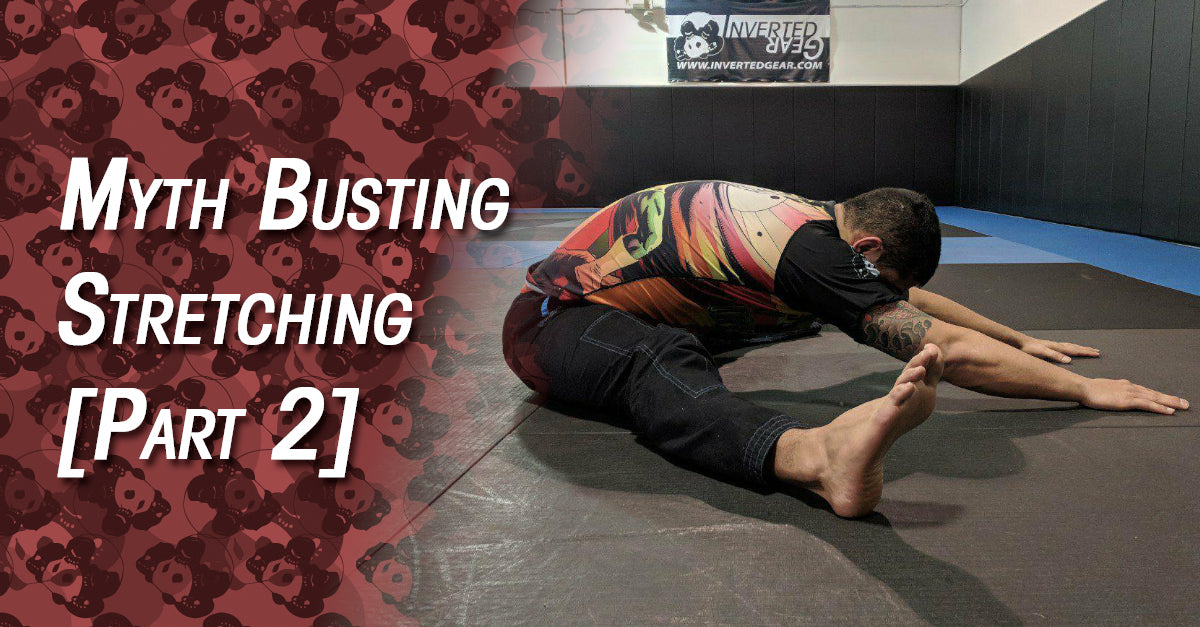Myth Busting Stretching [Part 2]

Let’s keep busting myths! Can stretching prevent muscle soreness? Is it bad to crack your knuckles? Does weightlifting make you less flexible? Is lactic acid evil? Time to find out!
(Read the first article of this series, “Laying the Groundwork for a Mobility Practice”, to get caught up.)
Does stretching reduce muscle soreness?
No, the research doesn’t show that stretching prevents soreness. Like I said in the first article, stretching can have a mild pain-killing effect, but it’s not going to prevent the delayed onset muscle soreness (DOMS) you feel a day or two after a hard workout. Ending a BJJ class with light “cool down” stretches feels good and can help you come down from the “fight mode” you put your nervous system in, but the price of stress on your body is soreness and fatigue. If constant soreness is a problem for you, make sure you are getting enough sleep, eating healthy, and drinking plenty of water, before you look into quick fixes.
Does stretching flush out lactic acid?
Let’s talk about lactic acid and why too much blame is placed on it.
When you feel that “burn” in your muscles from a hard workout or a tough night of sparring, someone likely told you are suffering the effects of lactic acid build up. After your first competition match, when your forearms seize up and your fingers are curled into claws, your coach probably told you the lactic acid needed to be massaged out of your muscles so you could use your hands again.
While lactic acid may play some role in muscle soreness, research does not find a strong link between the two. Sames goes for muscle cramps. Lactic acid does build up in muscles during exertion, but it quickly disappears. In recent years, researchers even found that lactic acid is not just a waste product, but consumed as a secondary fuel for more energy. This article from Sports Illustrated explains it in more depth.
To answer the original question, stretching does not flush out lactic acid in any special way, but now we know it likely wouldn’t matter even if it did.
Is it bad to crack my joints?
Cracking your joints is not bad for you. You may even feel relief and a sense that your joints are looser afterward. You will not give yourself arthritis or make your knuckles thicker (grip fighting and spider guard are more likely to do that).
So what causes that loud crack or pop? Weirdly enough, that’s the sound of gas bubbles popping in and out of existence. This video explains it:
What about those little clicks and crunches I hear inside my joints?
This is normal and usually not a problem if it causes no pain. The medical term for this is crepitus. You can probably create the effect right now in your neck by turning your head in a big circle to look up at the sky. These sounds can be caused for the same reason as cracking joints, or because of little bits of debris and junk in the joints. This is usually not cause for concern, unless you feel pain or unpleasant grinding sensations that signal something worse like bone spurs.
Do strength training, bodybuilding, and weight lifting make you inflexible?
Being strong does not make you inflexible, but you shouldn’t be surprised if you get stiff doing strength training without also working on your flexibility and mobility. Your body simply tries to get better at whatever you make it do often and under stress, so if that’s just bracing yourself to pick up heavy objects in limited ranges of motion, that’s what you get. You can do mobility training in conjunction with your strength training if you want to increase your mobility as you get stronger.
Does stretching make you weaker?
No, not permanently, at least. Static stretching has been shown to temporarily lower max muscle activation, perhaps as a neurological safety mechanism to prevent you from accidentally hurting yourself when you’re at extreme end ranges. This effect wears off relatively quickly, so while you wouldn’t want to do long stretches before training (and why the current recommendation is to do dynamic stretches for warm ups), they are still useful at other times for increasing flexibility.
But to repeat what I said in the answer to the last question -- that your body only improves at what you make it do -- holding long static stretches to gain flexibility without doing anything to gain strength and control in those ranges means you have a new range you are weak in. That’s why the distinction between flexibility and mobility is useful, since mobility includes gaining strength in new ranges.
---
Those were the confusions I had when I first started learning about stretching and mobility, and now you’ve got the answers to them, too. When we continue this series in Part 3, we will get into what it takes to create joint health and how to make daily mobility gains through the practice of Controlled Articular Rotations (CARs) as taught in Functional Range Conditioning. Until then, and as always, let us know if you have any specific questions or problems you want addressed next time!
Other articles:
Quick links
Contact us
About us
Quality BJJ gear at fair prices, available all year. Founded in 2012 to provide an alternative to high-cost, limited edition gis. Dive into the BJJ lifestyle with us—join the Panda Nation!"
